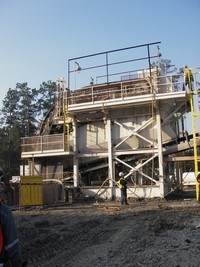Vale Inco has decided against acquiring a vertical conveyor system for its Garson Deep project. The novel material handling system was considered as an alternative to several more conventional options, including the deepening of the existing shaft, the construction of a winz and the extension of an existing ramping system.
Garson Mine’s number two shaft currently descends to the 4,242-foot level. From there, a ramp winds down to the 5,100-foot level, but Vale Inco has its sights set on an indicated and inferred resource of seven million tonnes all the way down to the 7,000-foot level.
An internal 1,250-foot (384 metre) vertical conveyor system would have been used to lift material to the 4,242-level and skip it to surface from there. The option was rejected because of the cost of installing the system underground, said Gary Poxleitner, senior mine evaluation engineer with Vale Inco’s mine project development group.
“When we ran the economics as part of the pre-feasibility study, we concluded that the cost was prohibitive. The initial cost of the vertical conveyor system was favourable, but transporting all of the components down the shaft and assembling the system underground would have added a considerable amount to the cost.”
Nevertheless, Poxleitner remains a big fan of the technology and advocates its use in other, more favourable underground mine scenarios.
“We have done what I believe is the most comprehensive study on the vertical conveyor system for underground mining in the world. We looked at all of the risks and did a lot of detailed work. The conclusion we came to was that a vertical conveyor system would be a very favourable option for a sub-level cave or block caving operation with a large orebody and a production rate of 5,000 to 20,000 tonnes per day. If you could maintain the head end of the system on surface, you wouldn’t have the logistical problem of moving these large components underground.”
In these circumstances, a vertical conveyor system would have a definite advantage over hauling material by truck up a ramp system, he said.
“There are a lot of mines with large orebodies where they’re ramping down and hauling up with trucks,” said Poxleitner. “Trucks are a good option if the tonnage is low, but if you want to move a lot of tonnes, you’re going to have a lot of trucks and at some point, they start interfering with each other.”
Having come to the conclusion that an extension of the ramp system at Garson Mine was the preferred solution, Poxleiter and members of the study team toured five mines in Australia to research best practices.
“The thing that stood out the most for us was the synching around truck haulage,” he said. “In Australia, the trucks always have to move. From the beginning to the end of the shift, they’re always hauling ore. When the operator finishes his shift, he parks the truck wherever he is, someone brings down the next operator and they switch.”
There was nothing new in relation to the gradient of the ramp or the way the ramps were designed, said Poxleitner. Optimizing the process was strictly related to increasing “seat time” and manpower scheduling.
“The maintenance staff and the truck operator, for example, would stagger their shift times. The maintenance guy would fuel the truck and do all the service 15 minutes before the operator comes, so when the operator starts his shift, he just jumps on the truck right away.
“Another thing they do is have all the trucks go underground together and then come up together, so they don’t have that interference issue, but the problem with that is you need a lot more ventilation.”
The feasibility study on Garson Deep is now scheduled to commence in January.



